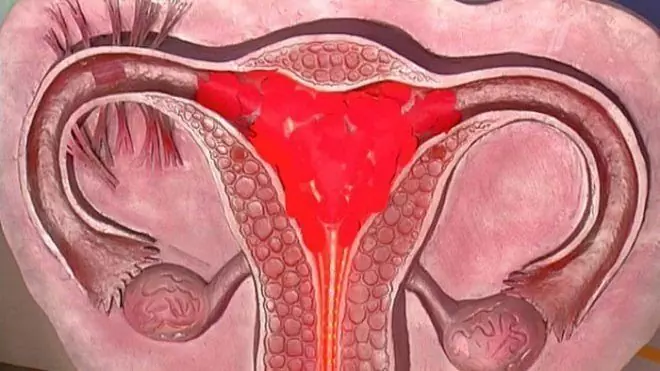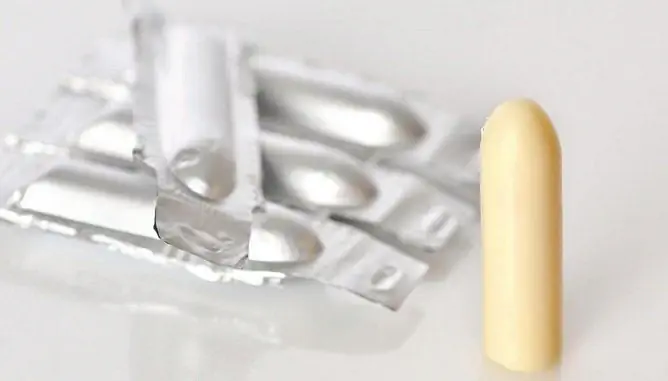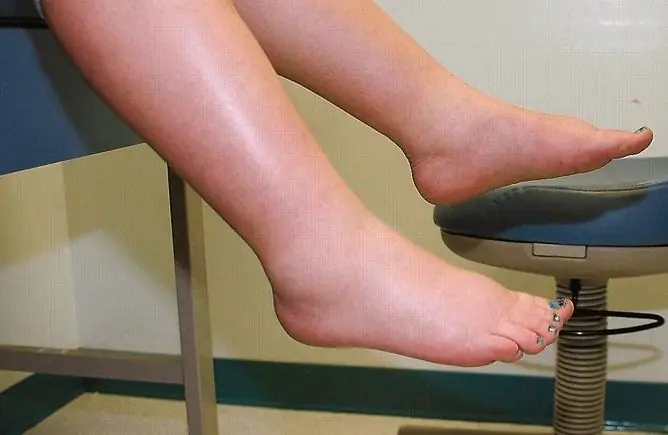- Author Rachel Wainwright [email protected].
- Public 2023-12-15 07:39.
- Last modified 2025-11-02 20:14.
Treatment of hemorrhoids after childbirth with breastfeeding
The content of the article:
- Approach to the treatment of hemorrhoids after childbirth
- Drug therapy for hemorrhoids during hepatitis B
- Physiotherapy exercises for hemorrhoids after childbirth
- Diet for hemorrhoids during lactation
- Alternative methods for treating hemorrhoids, acceptable for HB
- Prevention of exacerbations of hemorrhoids
- Hemorrhoids after childbirth
Breastfeeding treatment of hemorrhoids after childbirth is required for many women. In the postpartum period, the body recovers after bearing and giving birth to a child, restructuring for another task - breastfeeding.
To determine the scope of treatment for hemorrhoids that have arisen or worsened during pregnancy and / or childbirth, take into account the data of an objective examination and, if necessary, the results of other studies.
Approach to the treatment of hemorrhoids after childbirth
Treatment of hemorrhoids after childbirth during breastfeeding (HB) cannot be carried out independently, it must be prescribed by a specialist and under his supervision, and the doctor must be informed that the patient is breastfeeding.

Treatment of hemorrhoids during breastfeeding requires a special approach to treatment, since not all drugs are approved for use
Treatment of postpartum hemorrhoids is complex, in most cases, conservative measures are sufficient:
- the use of local anti-inflammatory and analgesic medicines (ointments, suppositories);
- adherence to a diet;
- physiotherapy.
In the absence of the effect of conservative therapy in a severe course of the disease, surgical treatment may be required, but if possible, it is postponed until the end of hepatitis B.
It is important to strictly adhere to the rules of personal hygiene, to move, to spend time in the fresh air. You cannot visit the bathhouse and sauna, as well as take a hot bath.
Drug therapy for hemorrhoids during hepatitis B
During lactation, they are very careful about the choice of drugs, since many of them are able to penetrate into breast milk and have an undesirable effect on the child's body, which significantly narrows the range of drugs that are permissible for use during this period.
In all cases, preference is given to topical drugs: ointments, suppositories, irrigations, baths. They are practically not absorbed into the systemic circulation and do not harm the child.
Internal hemorrhoids occur in about 70% of patients after childbirth. In this form of the disease, drugs are usually used in the form of suppositories. In the case of the development of external hemorrhoids, as a rule, drugs are used in the form of an ointment or cream.
Anti-inflammatory drugs for the therapy of hemorrhoids in the form of suppositories promote rapid healing of cracks, stop bleeding, and relieve pain. Usually, suppositories can be used from the first days after childbirth. Some of them can be used after each bowel movement (but not more than 4-6 times a day), others 1 time a day - in the morning after a bowel movement or at night before bedtime.
Before the introduction of the suppository, it is necessary to wash your hands and the anal area, then unseal the suppository and insert it as deeply into the rectum as possible. After completing the manipulation, you should thoroughly wash your hands. After the introduction of the suppository, it is recommended to take a horizontal position for a few minutes.
Systemic drugs are prescribed only for strict indications. When taking some of them, a woman is advised to stop breastfeeding. If she plans to continue hepatitis B, then during the period of taking the medicine, milk should be expressed and poured out, and the child should be fed with an adapted formula (you should first consult with the pediatrician or visiting nurse regarding the choice of the formula). Some drugs of general action are acceptable for nursing mothers, in this case there is no need to interrupt lactation. The course of drug therapy is 1-4 weeks.
During lactation, plant-based laxatives, analgesics, and drugs that improve vascular tone and blood circulation can be prescribed. A mild laxative, acceptable for nursing, prevents overstrain of the rectum, as it facilitates the process of defecation if the patient has constipation. Phlebotropic drugs can also be prescribed, which help to strengthen the vascular wall, normalize the tone of the veins, and also have an anti-inflammatory effect.
During drug therapy of hemorrhoids with drugs of general action of a nursing mother, it is necessary to carefully monitor the condition of the child. If there are any changes, you should immediately notify your doctor.
Physiotherapy exercises for hemorrhoids after childbirth
Since hemorrhoids are associated with blood congestion, exercise therapy is one of the most effective treatments for hemorrhoids. The advantage of this method is its complete safety for a breastfeeding woman.
The set of exercises is selected by the doctor individually, since it depends on a number of factors and, first of all, on the general condition of the patient. Most popular exercises:
- tension and relaxation of the sphincter (Kegel exercises), allowing to activate local blood flow;
- wide swing legs while lying on the floor on your back (exercise "scissors");
- rotation of the legs (exercise "bike").
The complex must be performed daily for at least 10 minutes, however, not allowing overvoltage.
Diet for hemorrhoids during lactation
Patients with hemorrhoids are shown a diet aimed at preventing constipation. At the same time, it must be fully balanced in terms of macro- and micronutrients, taking into account lactation.
Fatty, spicy, salty, spicy and smoked foods, strong tea and coffee, products that contribute to increased gas production are excluded from the diet. It is also recommended to limit the consumption of pears, muffins, pasta and confectionery.
The diet should contain cereals (buckwheat, oatmeal), bran, dried fruits (prunes, dried apricots, raisins) and vegetables, fresh and stewed. Such products help to increase the volume of feces and normalize intestinal motility.
Lactic acid products, boiled or baked meat and fish, bananas, apples, vegetable oils, pumpkin and sunflower seeds, walnuts are recommended.
It is important to drink enough liquid (at least 1.5 liters of water per day).

The diet for hemorrhoids in breastfeeding women should be balanced and aimed at improving bowel function
Alternative methods for treating hemorrhoids, acceptable for HB
In addition to the main treatment for hemorrhoids in breastfeeding women, traditional medicine can be used. According to the patients' reviews, in the initial stages of the disease, irrigation and baths from decoction of chamomile, onion husks, St. John's wort, and oak bark have proven themselves well. Use compresses from grated potatoes, treatment of the affected area with rowan juice, cedar or sea buckthorn oil. Baths are made with the addition of a decoction of wild strawberry leaves, nettle, chamomile.
When resorting to traditional medicine, one should be limited only to topical preparations. It is often possible to find statements about the complete harmlessness of folk remedies based on medicinal plants, for which reason, unlike tablets, they are recommended to be taken orally with HB. This opinion is erroneous. When taken orally, these drugs can also pass into breast milk and affect the baby's body, in addition, many of them are highly allergenic.
Before treating hemorrhoids with folk remedies, you should consult with your doctor.
Prevention of exacerbations of hemorrhoids
The main preventive measures that prevent exacerbation of hemorrhoids include:
- compliance with the rules of personal hygiene;
- balanced diet;
- sufficient physical activity;
- avoiding excessive physical exertion, especially lifting weights.
Hemorrhoids after childbirth
Hemorrhoids is a disease in which hemorrhoids form against the background of inflammation, thrombosis, pathological expansion of the veins of the rectum.
Hemorrhoids are a widespread pathology in women during pregnancy and lactation. Usually, the disease develops during gestation, when the growing uterus begins to press on the pelvic organs, as a result of which an increase in intra-abdominal pressure occurs. The development of the pathological process is facilitated by constipation, overweight, hormonal imbalance, insufficient physical activity. The provoking factors include inappropriate nutrition, wearing tight underwear, hereditary predisposition (hereditary weakness of the walls of blood vessels).
Hemorrhoids are internal and external. With external hemorrhoids, the nodes are located in the anal area around the sphincter, with internal - in the anal canal. In addition, hemorrhoids can be acute and chronic. The main manifestations of hemorrhoids include pain during bowel movements, the appearance of red blood in the feces and / or on underwear, and constipation. In the acute form of hemorrhoids, pain is more pronounced than in chronic.
In most cases, hemorrhoids that develop during pregnancy or childbirth will reverse as the body recovers.
YouTube video related to the article:

Anna Aksenova Medical journalist About the author
Education: 2004-2007 "First Kiev Medical College" specialty "Laboratory Diagnostics".
Found a mistake in the text? Select it and press Ctrl + Enter.






